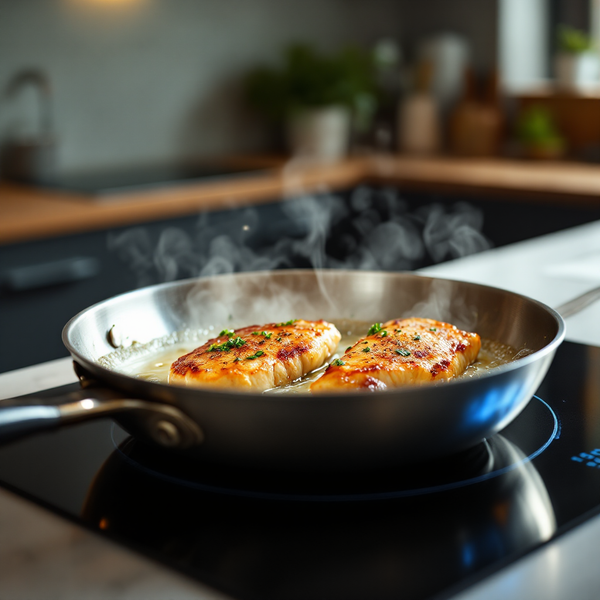Cooking with magnets: Intro to induction burners
I explore the science behind induction technology, share my personal experiences with different units, and begin the search for the perfect induction to apply the “energy” element of cooking.
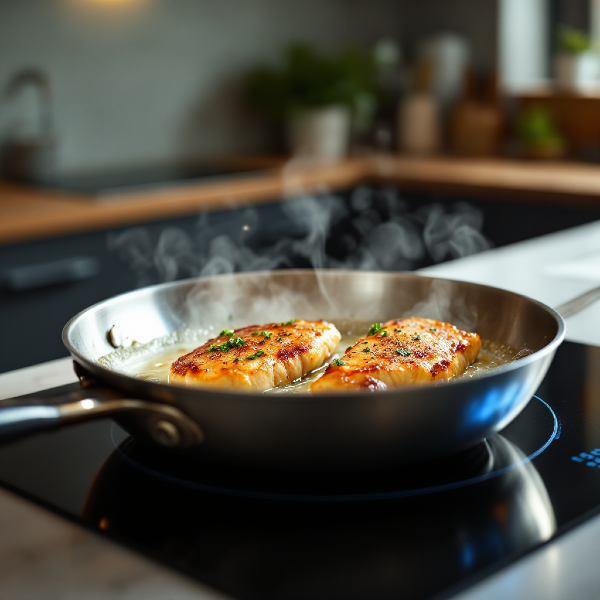
Introduction
The kitchen is where science, technology, and passion collide—part lab, part workshop, part playground. Ingredients are left to mellow, reactions are coaxed with just the right amount of energy, and in the end, something greater than the sum of its parts emerges: a creation that satisfies both curiosity and appetite.
For years, I've been fascinated by how different cooking methods apply energy to our food. While traditional gas and electric cooktops have long dominated kitchens, induction technology takes a fundamentally different approach—one that promises precision, efficiency, and control. In this article, we'll explore the science behind induction cooking, compare it with traditional methods, and dive into my personal journey experimenting with induction burners. From the physics of electromagnetic heat transfer to the practical realities of choosing the right equipment, I'll take you through the calculated curiosity that led me to embrace this technology.
Types of cooktops: A matter of energy transfer
Energy can be applied to transform ingredients very precisely (e.g. “bake at 375° for 15 minutes”) or in an “unleash the gates of hell and you’re probably going to end up scraping the burnt bits off as you’re absolutely going to miss that one second window of where it goes from cooked to ash” approach (e.g. “broil for 7 minutes or until done”). I’m not sure why I’m talking about the oven as this is an article about stovetop cooking, but you get the point.
When it comes to stovetops, you have two and a half options: gas range, electric range, or hybrid. Diving deeper, we find that gas can be natural gas or propane, while electric can be radiant, inductive, or old-school coil. Jumping ahead, the most efficient (in terms of energy transfer) is the induction cooktop as it nears 80-90% efficiency whereas other electric cooktops are about 70-80% efficient and gas cooktops are only 30-40% efficient, with most of the energy lost to the surroundings (source1 source2). If electricity wasn’t so expensive here in California, we’d all be using electric cooktops and heaters – let’s not even get into how unhealthy the indoor air quality can get when using your stove or oven.
How induction works: Electromagnetics in your kitchen
Energy efficiency is one benefit of an induction cooktop, but there’s also the element of being able to more precisely control the temperature of your cookware – enabling faster, more accurate, and repeatable adjustments. This brings us back to the oven example: where a gas stove involves a lot of guessing and tweaking of the knob to get the temperature right (the broiler approach), induction cooktops allow us to precisely control the energy transfer (the oven approach) to get the desired outcome.
Where standard electric cooktops use a resistive coil to generate heat (direct or infrared heat), an induction cooktop doesn’t actually create any heat that’s transferred to the cookware. Instead, they act as electromagnets that rapidly switch their magnetic fields to excite the magnetic particles in the cookware, generating heat as a byproduct of this interaction. Similar to how a microwave heats by exciting water molecules in your food, an induction cooktop excites metal particles in your pan which then transfer heat to your food. By skipping the step of creating heat which then needs to transfer to the pan, we increase efficiency and reduce the lag in controlling the input energy.
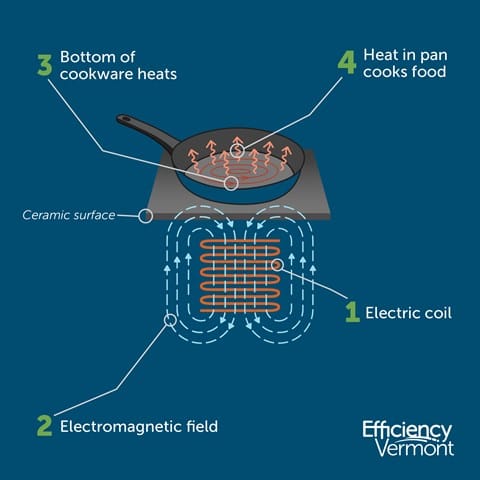
I haven’t even mentioned the ease of cleaning induction cooktops (and radiant cooktops) compared to gas ranges or resistive coils. Since you don’t have all of those parts that stack together with a ton of crevices where food and spills get trapped and baked on - as though the designers only focused on aesthetics and not the punishment those of us who like to cook would have to endure. That reminds me, I need to clean the kitchen – I keep putting it off because I dread taking the gas stovetop apart again to clean all the nooks and crannies.
A few months ago we stayed at an Airbnb with a full induction cooktop, and it was amazing to cook on and clean! I think they might have a future.
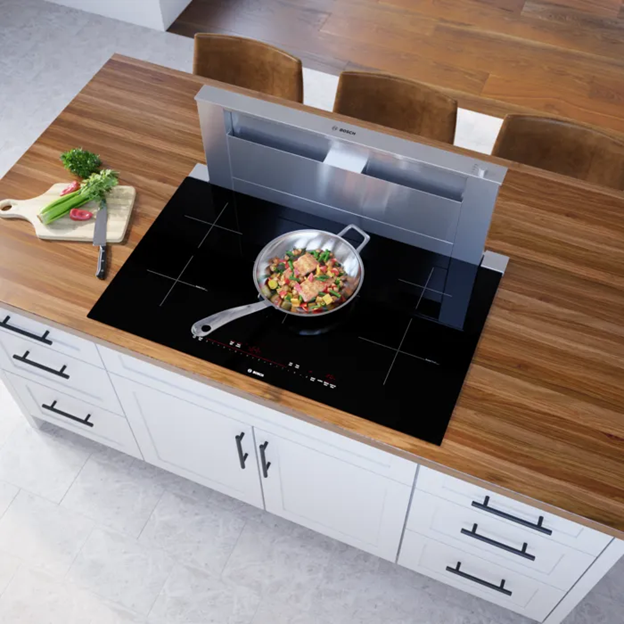
My first taste of an induction burner
I’d wanted an induction burner for some time (how could you not after reading this far?). I’m focusing on induction burners (standalone, single-burner units) as I want to try cooking with induction before going all in (and I don’t own the house I currently live in so I can’t really rip out the entire stovetop and replace it). Funny enough, I found one laying on the side of the road one day (literally), so I took it home and cleaned it up.
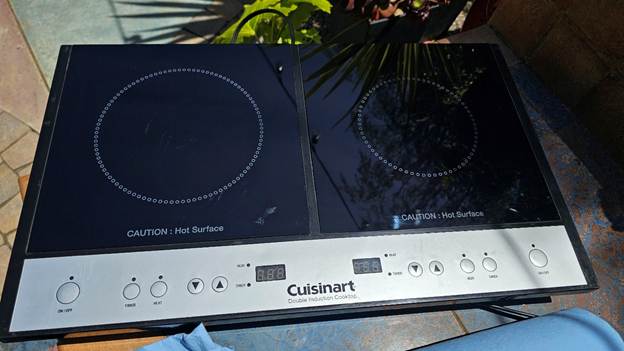
Interestingly, this model has two burners. Unfortunately, this model has two burners. Why is it unfortunate you may ask? Well, household appliances are generally rated at up to 15 amps, meaning they can draw up to 1,800 watts. Theoretically, your kitchen has multiple 20A circuits to give you some headroom and allow you to use multiple appliances at once, but that’s not always the case.
Regardless, this appliance can only draw up to 1800W total, and it’s not smart enough to adjust the power draw between a single burner being on versus both burners. The way they designed this unit, the large burner maxes out around 1200W and the smaller burner around 600W. But it’s free, in my house, and worth trying out. I put a cutting board across the burners on my stove (take that difficult-to-clean gas stovetop!) and rested the induction burner on top so I could vent those delicious cooking smells.
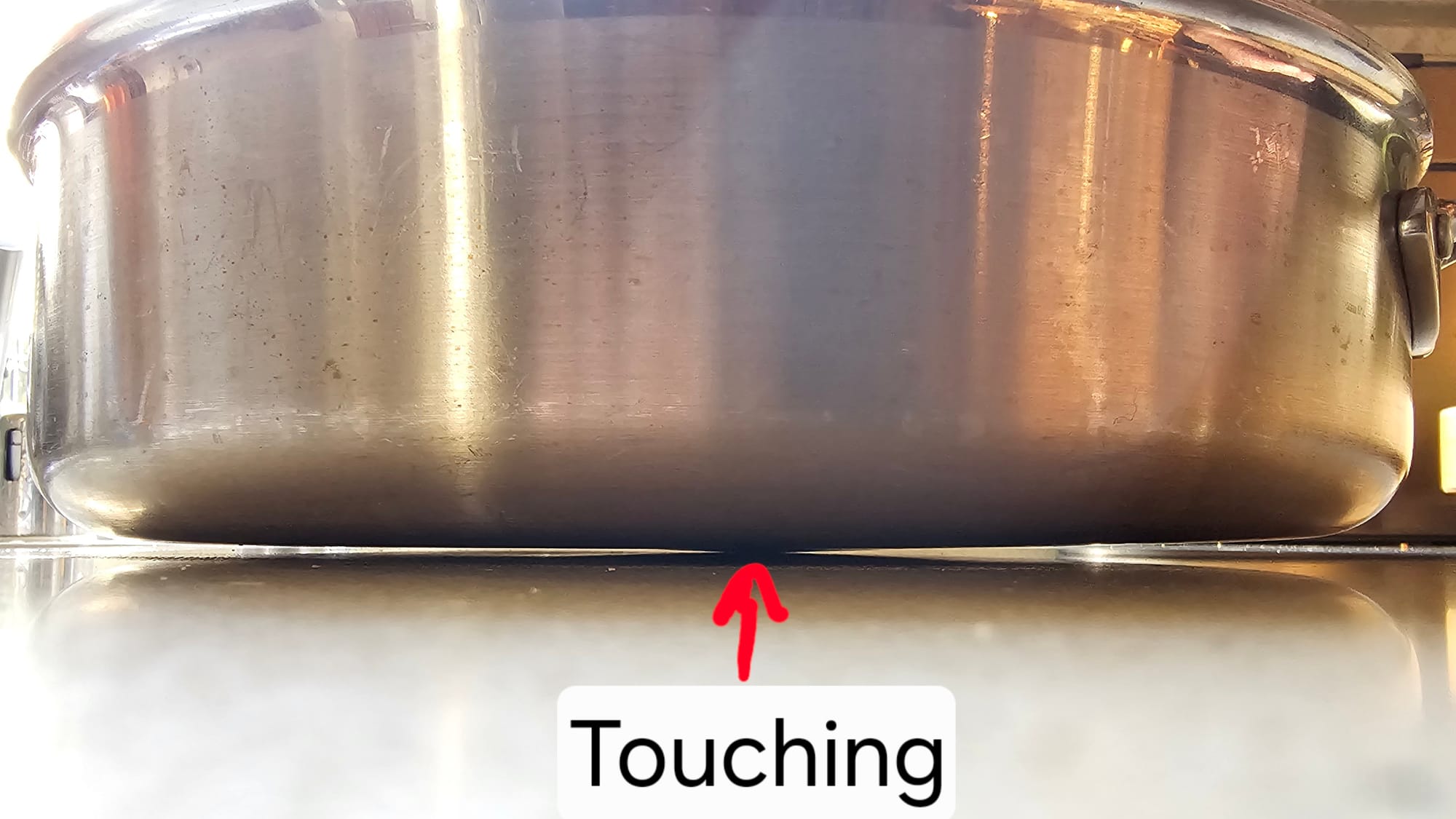
The first thing I figured out was that not all of my pans were induction-ready – most were, the nonstick pans weren’t – bummer. The second thing I noticed was that my larger pans are warped from years of high heat, causing the center of the pan to bulge out (down) and the pan to spin around this axis. Funny enough, the induction currents make the pan vibrate just enough when it’s balancing on that bulge that the pan starts to spin around and dance with the most ear-piercing sound.
The squeal of induction
The induction burner works by oscillating magnetic fields to induce micro-vibrations in the base of the cookware to produce heat. These vibrations can cause the cookware to micro-dance just enough that it produces an extremely high-pitch sound – not micro. This is more likely to occur if the bottom of your cookware isn’t perfectly flat, or, I’ve also noticed the vibration manifests as chatter in the lid of a pot when there’s enough steam built up inside. Both of these can be very annoying, if not deafeningly so.
Another source of that ear-piercing high pitch sound can be the cheap electronics found in many imported cooktops. Transformers, rectifiers, inverters, etc. can create squealing or buzzing sounds (especially at high power) based on the current rushing through the components. This is the reason I plug my induction burner into a smart switch - to cut power when the unit is in standby to kill the phantom power draw (since many of these cheaper units don’t fully turn off) and stop the buzz of the cheap electronics. The only reasons it’s a smart switch (instead of manually unplugging) are that a) I’m too lazy to plug/unplug and don’t want the extra wear on the plug from that, and b) sometimes I forget to unplug/turn off the switch after cooking (especially since the fan will continue running for a minute to cool down the internals after things got toasty), so I can yell at my Google machine to turn of the burner.
In summary: buy good quality cookware, make sure your pans aren’t warped, don’t buy cheap imported “stuff”, and embrace strategic laziness.
Cooking with induction
Let’s get cookin! I wanted to experiment with induction because it promises thermal efficiency, precise control, and rapid response. So how did it go?
We’ve already covered how efficient the energy transfer is but glossed over how much less ambient heat is produced in your kitchen. This is where induction beats gas and other electrical cooktops: with so little energy wasted, the only hot thing in your kitchen is the pot – that actual vessel you’re cooking in. What a concept! We don’t need a hot stovetop because we’re not frying the egg on the metal burner or glass-ceramic top – that’s just contributing to heating up our kitchen. So, A+ there. I never understood the point of air fryers since I already had a convection oven, but being able to run an air fryer outside (not recommended, maybe?) in the middle of summer for half an hour vs heating up my oven and house for 45+ minutes (factoring in time to preheat, which then needs to also be cooled by the AC) actually made sense. Similar idea here, plus you don’t need to run the exhaust hood just to vent the byproducts of burning gas, keep more of conditioned air inside.
When a recipe calls for “Low” heat or “Medium” what does that mean? Each burner is a different size, and the markings on the knobs seem pretty arbitrary. But I bet you know what it means to set your oven to 375° (interestingly, it’s not what most people think – a different rabbit hole for another time). An induction burner has a clear scale: from 0 watts (off) to 1800W (for a countertop model). Medium would logically be around 900W – and you can directly dial that in! Some burners have 6 power settings, others have many more – many let you dial in a temperature you want the pan to hold, but I think that’s nonsense (I’m convinced it’s just a lookup table of power to temp, not using a thermistor). Fancy models even have temperature probes that you can place in your pot so create a pseudo-sous vide environment, which is great for confectionery making and similar precision cooking. And if you had a great result frying an egg at 800W for 2 minutes, it’s repeatable! Take that, arbitrary gas stove knob increments!
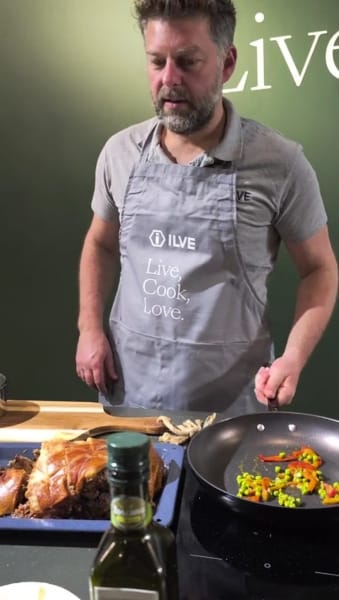
I attended the Kitchen and Bath Industry Show (KBIS) in 2024 at the Ilve booth (dreamy appliances) for a cooking demo by OurRustica (it’s always fun to have Italians cooking for you), and that was the first time I experienced the responsiveness of an induction cooktop. Mind you, this was a 240V induction range, but the contents of the pan went from cold to sizzling in a matter of seconds, and a boil reduced to a simmer instantly. Their website specs show the range going up to 3200W, nice!
With induction, you’re only limited by your cookware’s thermal responsiveness (don’t try this with cast iron). Fiddling with knobs and carryover heat from hot grates or trapped beneath the glass surface are worries of the past. Just dial in the power setting you want, and your cookware responds almost immediately. It’s very satisfying to boil water since you apply all the energy directly to the pot, immediately.
What I look for in an induction burner
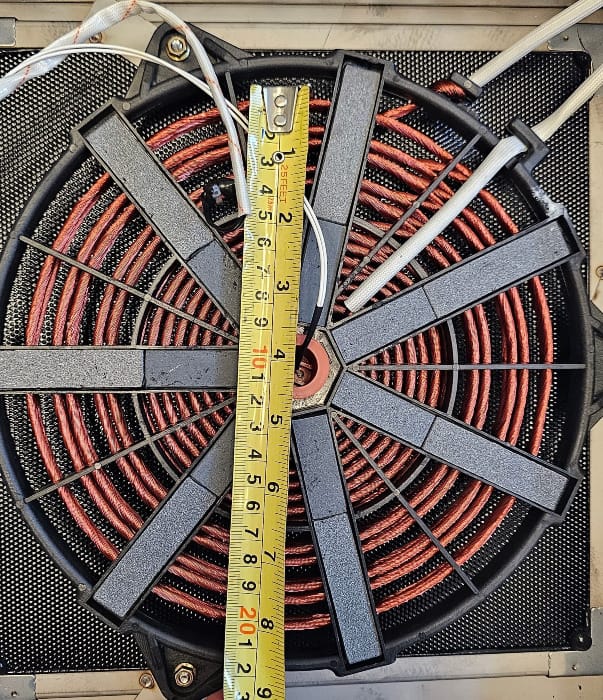
Sometimes I’m frying an egg or two for myself in a 6.5” pan while other times I’m frying chicken breasts or simmering a stock in an 11.5” pan or pot (referring to the diameter of the base). Usually, you pick the burner on your conventional stovetop that best matches the size of your cookware, but with a single induction burner, you don’t have a choice. So how do you find a one-size-fits-all solution? Simple - you can’t! Most manufacturers opt for an induction coil with a 6-7” diameter. That’s fine for a 6.5” pot or pan, but that’s probably my least frequently used size. Can you imagine my disappointment when I preheated my 11.5” cast iron skillet on the 6.5” burner and put my chicken down to fry, and the outer few inches of the pan weren’t even hot enough to sizzle? Oof, that’s annoying. Don’t forget, the highest output of a single burner (on the dual burner setup I was using) was ~1200W. Well, there are two things to add to my wish list – coil size and power output.
The third and fourth factors are the controls and cleanability. Push buttons and capacitive buttons are great in theory – they’re easy to wipe clean – but going from 1800W to 400W at 100W increments is a lot of button pushes (to go from a boil to a simmer). Many times, I felt ridiculous standing there tapping the up/down buttons repeatedly to adjust the power – it’s great having such control, but that’s a lot of button pushes to keep a pot from boiling over. Is the solution fewer increments or shortcuts or something else? Whatever it is, it better be easy to clean since that’s a huge selling point of having a flat glass surface (it’s amazing to be able to just wipe down the grease splatter/boiled over whatever with one swipe!).
Finally, that ear-piercing, high-pitch squeal – yeah, let’s minimize that.
Wait, one more! In my search for a replacement (taste of coming attractions) I found that the annoying cycling of the element on/off (you know what I’m talking about if you ever used any type of electric cooktop) didn’t have to be. More advanced electronics could maintain lower heat settings without cycling the element (similar to how Panasonic revolutionized the microwave industry with Inverter technology), adding another dimension to precision cooking.
The search for an induction burner
It’s time to upgrade. Amazon has the widest selection (obviously) from brands with the strangest names (interesting story about why - another rabbit hole).
Luckily, my search focused on coil size since this was the most significant shortcoming of my existing burner – this narrowed the search down drastically as most options are in the 6-7” range. The largest coils I could find in consumer, 120V burners were advertised as 9”, and there were only two brands: “GastroGear” and “Abangdun” (oh Amazon and your silly names). Both brands had two variants each, a consumer and commercial style. And if you look closely, they look nearly identical (more on that in the review).
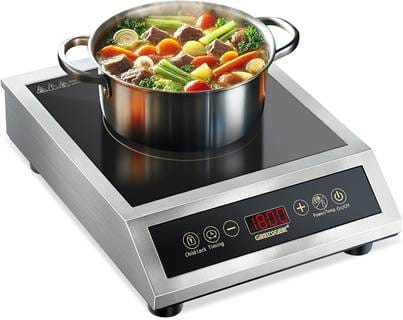
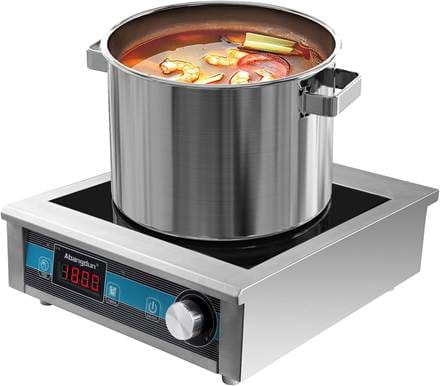
So, what did I do? I contacted the seller to ask for more information about the difference between the models and if the cheaper one would satisfy my needs since the consumer model was on sale for $140 vs. the commercial model listed for over $200. I received confirmation of the 9” coil (noted compatibility of 6”-16” pot sizes with 12” being the sweet spot – umm?) and an upsell about how much better and (physically) stronger the commercial model was. Of course, I ordered the cheaper one (which is currently marked down to $100 – perhaps my scathing review has something to do with that), but later I replaced it with the commercial model.
Hands on: A tale of two burners
As you might have guessed from my hints throughout this article, my experience with the consumer model was less than stellar. In my next post, I'll dive deep into what went wrong, what went right, and what ultimately led me to upgrade to the commercial model. I'll break down the technical specifications, performance differences, and whether the extra cost was justified. For now, I'll leave you with this: induction cooking offers remarkable precision and efficiency that can transform your cooking experience—but not all induction burners are created equal. The difference between a frustrating kitchen gadget and a game-changing tool often comes down to engineering details that aren't visible in product listings or marketing materials. Stay tuned for my detailed review of both models, where I'll take apart the units (literally) to show you what's happening beneath the glass.


